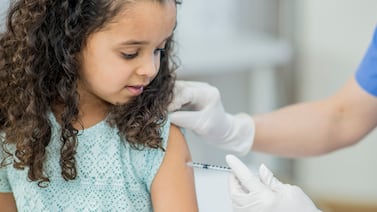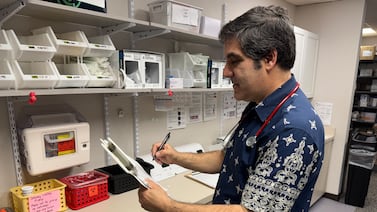Public health, explained: Sign up to receive Healthbeat’s free national newsletter here.
Six people who work at a poultry farm in northeastern Colorado have tested positive for the bird flu, the Centers for Disease Control and Prevention reported Friday. This brings the known number of U.S. cases this year to 10.
The workers were likely infected by chickens, which they had been tasked with killing in response to a bird flu outbreak at the farm. The endeavor occurred amid a heat wave, as outside temperatures soared to 104 degrees Fahrenheit.
“The barns in which culling occurs were no doubt even hotter,” said CDC principal deputy director Nirav Shah at a July 16 press briefing. Wearing N95 respirators, goggles, and other protective gear was a challenge. Industrial fans whipped feathers around the facility that could have carried the virus, Shah added.
In this environment, the farmworkers collected hundreds of chickens by hand and placed them into carts where they could be killed by carbon dioxide gas within two minutes.
“If a farm worker gets severely ill or dies from an H5N1 infection, it will be a stain on U.S. public health that we didn’t do more with the tools we have,” Jennifer Nuzzo, director of the Pandemic Center at Brown University, posted on X. “You don’t send farm workers in to cull H5N1 infected birds without goggles and masks. Period. If it’s too hot to wear those protections, it’s too hot to cull. We need vaccines to be made available to farm workers. We have to stop gambling with peoples’ lives.”
More than 99 million chickens and turkeys have been infected with a highly pathogenic strain of the bird flu that emerged at U.S. poultry farms in early 2022. Since then, the federal government has compensated poultry farmers more than $1 billion for destroying infected flocks and eggs to keep outbreaks from spreading.
Virus shifts to dairy cattle
As summer temperatures rise across the country, Shah said, the agency is contending with how to offer farmworkers “safety from the virus, as well as safety from extreme heat.”
The H5N1 bird flu virus has spread among poultry farms around the world for nearly 30 years. An estimated 900 people have been infected by birds, and roughly half have died from the disease.
The virus made an unprecedented shift this year to dairy cattle in the U.S. This poses a higher threat because it means the virus has adapted to replicate within cows’ cells, which are more like human cells. The four other people diagnosed with bird flu this year in the U.S. worked on dairy farms with outbreaks.
Scientists have warned that the virus could mutate to spread from person to person, like the seasonal flu, and spark a pandemic. There’s no sign of that, yet.
So far, all 10 cases reported this year have been mild, consisting of eye irritation, a runny nose, and other respiratory symptoms. However, numbers remain too low to say anything certain about the disease because, in general, flu symptoms can vary among people with only a minority needing hospitalization.
The number of people who have gotten the virus from poultry or cattle may be higher than 10. The Centers for Disease Control and Prevention has tested only about 60 people over the past four months, and powerful diagnostic laboratories that typically detect diseases remain barred from testing for bird flu. Testing of farmworkers and animals is needed to detect the H5N1 bird flu virus, study it, and stop it before it becomes a fixture on farms.
Researchers have urged a more aggressive response from the CDC and other federal agencies to prevent future infections. Many people exposed regularly to livestock and poultry on farms still lack protective gear and education about the disease. And they don’t yet have permission to get a bird flu vaccine.
CDC decides against vaccination
Nearly a dozen virology and outbreak experts recently interviewed by KFF Health News disagree with the CDC’s decision against vaccination, which may help prevent bird flu infection and hospitalization.
“We should be doing everything we can to eliminate the chances of dairy and poultry workers contracting this virus,” said Angela Rasmussen, a virologist at the University of Saskatchewan in Canada. “If this virus is given enough opportunities to jump from cows or poultry into people, it will eventually get better at infecting them.”
To understand whether cases are going undetected, researchers in Michigan have sent the CDC blood samples from workers on dairy farms. If they detect bird flu antibodies, it’s likely that people are more easily infected by cattle than previously believed.
“It’s possible that folks may have had symptoms that they didn’t feel comfortable reporting, or that their symptoms were so mild that they didn’t think they were worth mentioning,” said Natasha Bagdasarian, chief medical executive for the state of Michigan.
In hopes of thwarting a potential pandemic, the United States, United Kingdom, Netherlands, and about a dozen other countries are stockpiling millions of doses of a bird flu vaccine made by the vaccine company CSL Seqirus.
Seqirus’ most recent formulation was greenlighted last year by the European equivalent of the FDA, and an earlier version has the FDA’s approval. In June, Finland decided to offer vaccines to people who work on fur farms as a precaution because its mink and fox farms were hit by bird flu last year.
The CDC has controversially decided not to offer at-risk groups bird flu vaccines. Demetre Daskalakis, director of the CDC’s National Center for Immunization and Respiratory Diseases, told KFF Health News that the agency is not recommending a vaccine campaign at this point for several reasons, even though millions of doses are available. One is that cases still appear to be limited, and the virus isn’t spreading rapidly between people as they sneeze and breathe.
The agency continues to rate the public’s risk as low. In a statement posted in response to the new Colorado cases, the CDC said its bird flu recommendations remain the same: “An assessment of these cases will help inform whether this situation warrants a change to the human health risk assessment.”
This update published July 19, 2024 at KFF Health News, Healthbeat’s national reporting partner.







